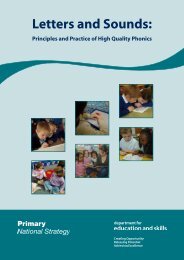What is the research evidence on writing? - Department for Education
What is the research evidence on writing? - Department for Education
What is the research evidence on writing? - Department for Education
Create successful ePaper yourself
Turn your PDF publications into a flip-book with our unique Google optimized e-Paper software.
language was Engl<str<strong>on</strong>g>is</str<strong>on</strong>g>h. The per<strong>for</strong>mance of most ethnic groups <str<strong>on</strong>g>is</str<strong>on</strong>g> similar <strong>for</strong> reading<br />
and <strong>writing</strong> outcomes.<br />
Key Stages 3 and 4<br />
In October 2008, <str<strong>on</strong>g>the</str<strong>on</strong>g> <strong>Department</strong> (<str<strong>on</strong>g>the</str<strong>on</strong>g>n DCSF) announced its dec<str<strong>on</strong>g>is</str<strong>on</strong>g>i<strong>on</strong> to d<str<strong>on</strong>g>is</str<strong>on</strong>g>c<strong>on</strong>tinue<br />
nati<strong>on</strong>al testing at Key Stage 3 (KS3) in Engl<str<strong>on</strong>g>is</str<strong>on</strong>g>h, ma<str<strong>on</strong>g>the</str<strong>on</strong>g>matics and science <strong>for</strong> 14 year<br />
olds (i.e. externally set and marked tests). Since <str<strong>on</strong>g>the</str<strong>on</strong>g>n pupils have been assessed<br />
through <strong>on</strong>-going teacher assessment, with regular real-time reports to parents. End<br />
of Key Stage teacher assessments c<strong>on</strong>tinue to be publ<str<strong>on</strong>g>is</str<strong>on</strong>g>hed at <str<strong>on</strong>g>the</str<strong>on</strong>g> nati<strong>on</strong>al and local<br />
authority level. NC tests were publ<str<strong>on</strong>g>is</str<strong>on</strong>g>hed <strong>for</strong> last time <strong>for</strong> <str<strong>on</strong>g>the</str<strong>on</strong>g> academic year 2007/08.<br />
Writing at KS3 <str<strong>on</strong>g>is</str<strong>on</strong>g> part of <str<strong>on</strong>g>the</str<strong>on</strong>g> Engl<str<strong>on</strong>g>is</str<strong>on</strong>g>h assessment. Teacher assessment results <strong>for</strong> 2012<br />
show that 84 per cent of pupils achieved level 5 or above, an increase of five<br />
percentage points since 2010 and ten percentage points since 2007. Ninety per cent<br />
of girls did so compared to 79 per cent of boys (DfE, 2012c).<br />
Key Stage 4<br />
Writing <str<strong>on</strong>g>is</str<strong>on</strong>g> not assessed separately at KS4 but it <str<strong>on</strong>g>is</str<strong>on</strong>g> part of <str<strong>on</strong>g>the</str<strong>on</strong>g> Engl<str<strong>on</strong>g>is</str<strong>on</strong>g>h assessment,<br />
toge<str<strong>on</strong>g>the</str<strong>on</strong>g>r with reading, speaking and l<str<strong>on</strong>g>is</str<strong>on</strong>g>tening.<br />
At KS4, <str<strong>on</strong>g>the</str<strong>on</strong>g> latest data shows that in 2011/12 in state-funded mainstream schools in<br />
England 568,600 pupils attempted a GCSE in Engl<str<strong>on</strong>g>is</str<strong>on</strong>g>h, and 69 per cent of those<br />
achieved a grade A*-C. The gender gap <str<strong>on</strong>g>is</str<strong>on</strong>g> still evident with 76 per cent of girls getting<br />
a grade A*-C compared to 62 per cent of boys.<br />
The percentage of pupils achieving <str<strong>on</strong>g>the</str<strong>on</strong>g> expected level of progress in Engl<str<strong>on</strong>g>is</str<strong>on</strong>g>h <str<strong>on</strong>g>is</str<strong>on</strong>g> <strong>on</strong>e of<br />
<str<strong>on</strong>g>the</str<strong>on</strong>g> main indicators in <str<strong>on</strong>g>the</str<strong>on</strong>g> GCSE tables: in 2012, <str<strong>on</strong>g>the</str<strong>on</strong>g> gap between <str<strong>on</strong>g>the</str<strong>on</strong>g> proporti<strong>on</strong> of<br />
girls and boys achieving <str<strong>on</strong>g>the</str<strong>on</strong>g> expected level of progress in Engl<str<strong>on</strong>g>is</str<strong>on</strong>g>h between Key Stage<br />
2 and Key Stage 4 was 12 percentage points, with 75 per cent of girls achieving so<br />
compared with 63 per cent of boys. The equivalent figures <strong>for</strong> 2007/08 were 70 per<br />
cent <strong>for</strong> girls and 59 per cent <strong>for</strong> boys, which suggest a big improvement in <str<strong>on</strong>g>the</str<strong>on</strong>g><br />
proporti<strong>on</strong>s of pupils making <str<strong>on</strong>g>the</str<strong>on</strong>g> expected progress and a reducti<strong>on</strong> in <str<strong>on</strong>g>the</str<strong>on</strong>g> gender<br />
gap. For compar<str<strong>on</strong>g>is</str<strong>on</strong>g><strong>on</strong> purposes, <str<strong>on</strong>g>the</str<strong>on</strong>g> equivalent figure <strong>for</strong> <str<strong>on</strong>g>the</str<strong>on</strong>g> gap in ma<str<strong>on</strong>g>the</str<strong>on</strong>g>matics in<br />
2012 <str<strong>on</strong>g>is</str<strong>on</strong>g> 4 percentage points (DfE, 2012c).<br />
38
















